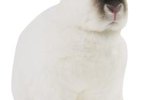
Your rabbit's long ears serve for more than hearing predators from a distance; they are also his personal air-conditioning unit. Meanwhile, the inner ear plays an important role in your rabbit's balance. Keeping his ears clean keeps them healthy. Make it part of his regular grooming routine.
Handling Your Rabbit's Ears
Your rabbit's ears are delicate structures; you can damage them with rough handling. Never restrain or pick up your rabbit by the ears, even when you're grooming them. Lift and open each ear gently, one at a time. If your rabbit tries to pull away, let go of his ear. Most rabbits don't like having their ears handled but will allow it if you do it gently. Let him get used to having his ears touched. Take breaks regularly while you acclimate him to your hands on his ears. After a while he will learn to trust you enough to let you handle them long enough for grooming.
Inspection
Before cleaning or grooming your rabbit's ears, give them a thorough inspection to check for any problems. Look at the inside of the ear for dirt, wax buildup, scabs or signs of anything unusual. The skin should appear clean. It should be supple and have a slight sheen. Sniff the ear near the opening to the ear canal: Often the first sign of an ear infection is a foul odor. A healthy rabbit's ear should not have an odor. If your rabbit's ears smell yeasty or unpleasant, take him to the veterinarian to have his ears checked. Look at the back or furred part of the ear and check for any signs of scratches, and feel around the base of the ear for scratches and matted fur. Scratches on the back or base of the ear are signals that your rabbit's ears are irritating him. A trip to the vet is in order.
Cleaning
Gently comb or clip out any matted fur at the base of the ear. Dip a cotton ball in rubbing alcohol, or a mild antiseptic solution such as chlorhexidine, and squeeze the excess out of the cotton ball out so it is damp but not saturated. Gently clean the visible inner area of your rabbit's ear using long strokes away from the ear canal. Don't push dirt or debris into the canal and don't attempt to clean the ear canal. Stroke very gently until all visible dirt, wax and grime are removed.
Fur
The fur on the back of the ear on most rabbits is so thin and fine it does not require regular brushing or grooming. The skin there is tender, and brushes and combs can cause pain. Your rabbit will probably do a good job of keeping this area clean himself; but if something does need removed, use a washcloth or rag dampened with water and gently wipe the back of the ear. For rabbits with wool, like angoras, Jersey Woolies, Fuzzy Lops or Lionheads, use a wide-tooth comb and brush through the hair at the base of the ear, along the back and at the tips gently.
Problems
Ear mites are common in rabbits; they spread rapidly between affected bunnies. The first signs often are what look like small pinpricks or scabs inside your rabbit's ears; your rabbit may scratch or shake his head frequently. Untreated, the scabs will multiply and could become infected, producing a smelly and crusty mess inside your rabbit's ears. Your rabbit can lose his sense of balance if infection becomes severe. Your veterinarian can prescribe treatment that will kill the mites and cure infections. Rabbits can develop ear infections without mites being present, but it's not common. Take your rabbit to the vet for treatment if he is having problems with his ears.



